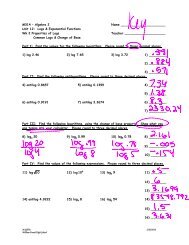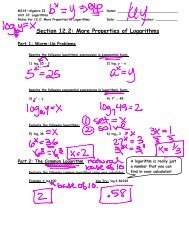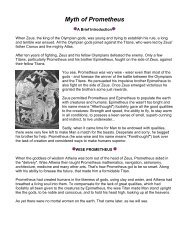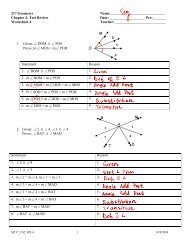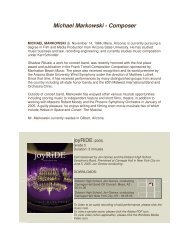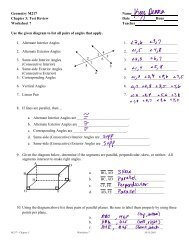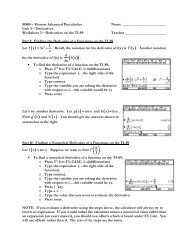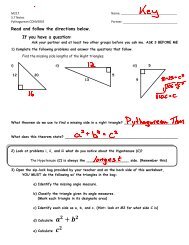Create successful ePaper yourself
Turn your PDF publications into a flip-book with our unique Google optimized e-Paper software.
The Government During <strong>World</strong> <strong>War</strong> <strong>II</strong><br />
During <strong>World</strong> <strong>War</strong> <strong>II</strong>, the government a played a heavy role in monitoring U.S. production, the economy, and<br />
communication. To support the soldiers fighting on the front lines, the government urged American farmers and workers<br />
to produce the food and equipment needed by U.S. and Allied troops. Roosevelt's administration controlled labor strikes,<br />
created a rationing system to control inflation, raised taxes to pay for the war, and censored communication to protect<br />
against leakage of strategic information.<br />
In 1942 President Roosevelt announced previously unheard-of production goals: 60,000 airplanes, 45,000 tanks, 20,000<br />
antiaircraft guns, and 8 million tons of merchant shipping. To meet these goals, Roosevelt created the <strong>War</strong> Production<br />
Board, which was responsible for converting factories and plants from consumer-oriented production to military<br />
production. Factories that had manufactured shirts redesigned assembly lines to make mosquito netting. Model-train<br />
producers made bomb fuses. Metal weather stripping factories switched to producing mortar shells. Kitchen-sink<br />
assembly lines were retooled to produce cartridge cases. All manufacture of automobiles switched to full-time production<br />
of tanks, trucks, armored personnel carriers, and aircraft. Because vital manufacturing materials, such as rubber, tin, and<br />
quinine, were in dangerously short supply, the government carefully rationed existing supplies.<br />
To meet the aggressive wartime production goals, the government felt the country could not afford delays in production<br />
that might be caused by labor disputes. To prevent potential problems, the government established the National <strong>War</strong><br />
Labor Board to settle labor disputes through mediation and arbitration. The board restricted wage increases to equal<br />
increases in the cost of living. Congress also passed the Smith-Connally <strong>War</strong> Labor Disputes Act, which required unions<br />
to give 30 days' notice before a strike vote, authorized the president to seize an essential industry where production was<br />
interrupted by work stoppages, and made it a federal crime to initiate or assist strikes in government-operated plants. In<br />
December 1943 Roosevelt had the army take possession of the nation's railroads to prevent a threatened strike by<br />
railway workers. It was returned to private management within a month.<br />
To pay for the war, the government had to raise huge amounts of money. It did so by raising taxes and by borrowing.<br />
Taxes reached as high as 94 percent for the highest incomes and still only amounted to 41 percent of the war cost. To<br />
supplement this income, the government borrowed from individuals through war bonds, from banks, and from<br />
corporations. Regular deductions, with the consent of the workers, were taken out of paychecks for bond purchases. The<br />
government mounted drives to sell bonds and boosted patriotic spirit using movie stars, and comic book heroes, such as<br />
Batman and Dick Tracy.<br />
Such methods of collecting money also served to safeguard against inflation. With employment high, most Americans<br />
had money to spend. Because few goods were available to buy during the war, prices rose rapidly. The government<br />
determined that if people loaned their money to the government for war bonds, they would have less to spend on goods<br />
and prices could be kept down.<br />
Roosevelt also established the Office of Price Administration (OPA) to help control inflation. The OPA set price ceilings<br />
on most items, and instituted rent control, since housing was scarce throughout the war. The agency created a system of<br />
rationing for such products as gasoline, tires, coffee, canned food, and meat. Under the rationing system, consumers<br />
were given a specific number of coupon books and stamps that stipulated their ration of goods. These measures<br />
succeeded in avoiding serious inflation during the war.<br />
To protect national security and strategic military information, Roosevelt issued an executive order that set up the Office<br />
of Censorship. This office censored all communications between the United States and other nations. Letters written by<br />
soldiers to their friends and families were censored to prevent leakage of important military information that could get into<br />
the hands of the enemy. The news media agreed to voluntary censorship, promising not to publish or broadcast<br />
information relating to military security without first clearing it with the federal government.<br />
The government also created the Office of <strong>War</strong> Information to keep the public informed on the progress of the war and<br />
the policies and aims of the government. It was hoped that this would make most news readily available; however, rigid<br />
government censorship stopped the spread of much detailed information. For example, it kept quiet a military blunder in<br />
the invasion of Sicily, Italy that resulted in an Allied bombing of U.S. paratroopers.



